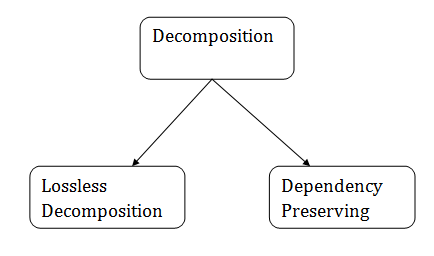Relational Decomposition
- When a relation in the relational model is not relationship normal form then the decomposition of a relation is required.
- In a database, it breaks the table into multiple tablinappropriatees.
- If the relation has no proper decomposition, then it may lead to problems like loss of information.
- Decomposition is used to eliminate some of the problems of bad design like anomalies, inconsistencies, and redundancy.
Types of Decomposition

Lossless Decomposition
- If the information is not lost from the relation that is decomposed, then the decomposition will be lossless.
- The lossless decomposition guarantees that the joining of relations will result in the same relation as it was decomposed.
- The relation is said to be lossless decomposition if natural joins of all the decomposition give the original relation.
Example:
EMPLOYEE_DEPARTMENT table:
| EMP_ID | EMP_NAME | EMP_AGE | EMP_CITY | DEPT_ID | DEPT_NAME |
|---|---|---|---|---|---|
| 22 | Denim | 28 | Mumbai | 827 | Sales |
| 33 | Alina | 25 | Delhi | 438 | Marketing |
| 46 | Stephan | 30 | Bangalore | 869 | Finance |
| 52 | Katherine | 36 | Mumbai | 575 | Production |
| 60 | Jack | 40 | Noida | 678 | Testing |
The above relation is decomposed into two relations EMPLOYEE and DEPARTMENT
EMPLOYEE table:
| EMP_ID | EMP_NAME | EMP_AGE | EMP_CITY |
|---|---|---|---|
| 22 | Denim | 28 | Mumbai |
| 33 | Alina | 25 | Delhi |
| 46 | Stephan | 30 | Bangalore |
| 52 | Katherine | 36 | Mumbai |
| 60 | Jack | 40 | Noida |
DEPARTMENT table
| DEPT_ID | EMP_ID | DEPT_NAME |
|---|---|---|
| 827 | 22 | Sales |
| 438 | 33 | Marketing |
| 869 | 46 | Finance |
| 575 | 52 | Production |
| 678 | 60 | Testing |
Now, when these two relations are joined on the common column "EMP_ID", then the resultant relation will look like this:
Employee ⋈ Department
| EMP_ID | EMP_NAME | EMP_AGE | EMP_CITY | DEPT_ID | DEPT_NAME |
|---|---|---|---|---|---|
| 22 | Denim | 28 | Mumbai | 827 | Sales |
| 33 | Alina | 25 | Delhi | 438 | Marketing |
| 46 | Stephan | 30 | Bangalore | 869 | Finance |
| 52 | Katherine | 36 | Mumbai | 575 | Production |
| 60 | Jack | 40 | Noida | 678 | Testing |
Hence, the decomposition is Lossless join decomposition.
Dependency Preserving
- It is an important constraint of the database.
- Independence preservation, at least one decomposed table must satisfy every dependency.
- If a relation R is decomposed into relations R1 and R2, then the dependencies of R either must be a part of R1 or R2 or must be derivable from the combination of functional dependencies of R1 and R2.
- For example, suppose there is a relation R (A, B, C, D) with a functional dependency set (A->BC). The relational R is decomposed into R1(ABC) and R2(AD) which is dependency preserving because FD A->BC is a part of relation R1(ABC).


0 comments:
Post a Comment
Thanks